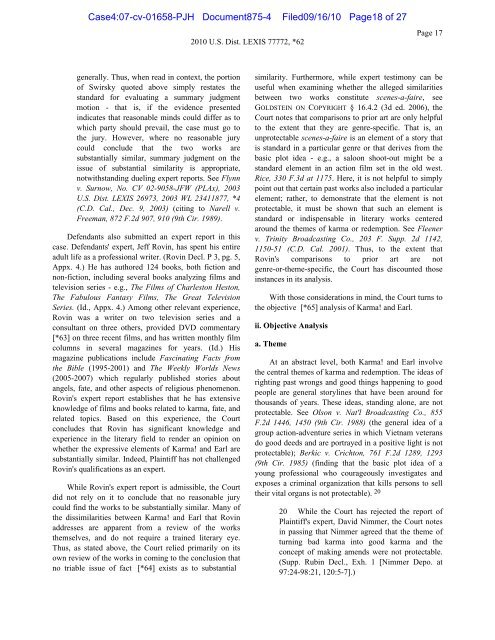exhibit 2 - SAP Lawsuit Portal
exhibit 2 - SAP Lawsuit Portal
exhibit 2 - SAP Lawsuit Portal
Create successful ePaper yourself
Turn your PDF publications into a flip-book with our unique Google optimized e-Paper software.
Case4:07-cv-01658-PJH Document875-4 Filed09/16/10 Page18 of 27<br />
generally. Thus, when read in context, the portion<br />
of Swirsky quoted above simply restates the<br />
standard for evaluating a summary judgment<br />
motion - that is, if the evidence presented<br />
indicates that reasonable minds could differ as to<br />
which party should prevail, the case must go to<br />
the jury. However, where no reasonable jury<br />
could conclude that the two works are<br />
substantially similar, summary judgment on the<br />
issue of substantial similarity is appropriate,<br />
notwithstanding dueling expert reports. See Flynn<br />
v. Surnow, No. CV 02-9058-JFW (PLAx), 2003<br />
U.S. Dist. LEXIS 26973, 2003 WL 23411877, *4<br />
(C.D. Cal., Dec. 9, 2003) (citing to Narell v.<br />
Freeman, 872 F.2d 907, 910 (9th Cir. 1989).<br />
Defendants also submitted an expert report in this<br />
case. Defendants' expert, Jeff Rovin, has spent his entire<br />
adult life as a professional writer. (Rovin Decl. P 3, pg. 5,<br />
Appx. 4.) He has authored 124 books, both fiction and<br />
non-fiction, including several books analyzing films and<br />
television series - e.g., The Films of Charleston Heston,<br />
The Fabulous Fantasy Films, The Great Television<br />
Series. (Id., Appx. 4.) Among other relevant experience,<br />
Rovin was a writer on two television series and a<br />
consultant on three others, provided DVD commentary<br />
[*63] on three recent films, and has written monthly film<br />
columns in several magazines for years. (Id.) His<br />
magazine publications include Fascinating Facts from<br />
the Bible (1995-2001) and The Weekly Worlds News<br />
(2005-2007) which regularly published stories about<br />
angels, fate, and other aspects of religious phenomenon.<br />
Rovin's expert report establishes that he has extensive<br />
knowledge of films and books related to karma, fate, and<br />
related topics. Based on this experience, the Court<br />
concludes that Rovin has significant knowledge and<br />
experience in the literary field to render an opinion on<br />
whether the expressive elements of Karma! and Earl are<br />
substantially similar. Indeed, Plaintiff has not challenged<br />
Rovin's qualifications as an expert.<br />
While Rovin's expert report is admissible, the Court<br />
did not rely on it to conclude that no reasonable jury<br />
could find the works to be substantially similar. Many of<br />
the dissimilarities between Karma! and Earl that Rovin<br />
addresses are apparent from a review of the works<br />
themselves, and do not require a trained literary eye.<br />
Thus, as stated above, the Court relied primarily on its<br />
own review of the works in coming to the conclusion that<br />
no triable issue of fact [*64] exists as to substantial<br />
2010 U.S. Dist. LEXIS 77772, *62<br />
similarity. Furthermore, while expert testimony can be<br />
useful when examining whether the alleged similarities<br />
between two works constitute scenes-a-faire, see<br />
GOLDSTEIN ON COPYRIGHT § 16.4.2 (3d ed. 2006), the<br />
Court notes that comparisons to prior art are only helpful<br />
to the extent that they are genre-specific. That is, an<br />
unprotectable scenes-a-faire is an element of a story that<br />
is standard in a particular genre or that derives from the<br />
basic plot idea - e.g., a saloon shoot-out might be a<br />
standard element in an action film set in the old west.<br />
Rice, 330 F.3d at 1175. Here, it is not helpful to simply<br />
point out that certain past works also included a particular<br />
element; rather, to demonstrate that the element is not<br />
protectable, it must be shown that such an element is<br />
standard or indispensable in literary works centered<br />
around the themes of karma or redemption. See Fleener<br />
v. Trinity Broadcasting Co., 203 F. Supp. 2d 1142,<br />
1150-51 (C.D. Cal. 2001). Thus, to the extent that<br />
Rovin's comparisons to prior art are not<br />
genre-or-theme-specific, the Court has discounted those<br />
instances in its analysis.<br />
With those considerations in mind, the Court turns to<br />
the objective [*65] analysis of Karma! and Earl.<br />
ii. Objective Analysis<br />
a. Theme<br />
Page 17<br />
At an abstract level, both Karma! and Earl involve<br />
the central themes of karma and redemption. The ideas of<br />
righting past wrongs and good things happening to good<br />
people are general storylines that have been around for<br />
thousands of years. These ideas, standing alone, are not<br />
protectable. See Olson v. Nat'l Broadcasting Co., 855<br />
F.2d 1446, 1450 (9th Cir. 1988) (the general idea of a<br />
group action-adventure series in which Vietnam veterans<br />
do good deeds and are portrayed in a positive light is not<br />
protectable); Berkic v. Crichton, 761 F.2d 1289, 1293<br />
(9th Cir. 1985) (finding that the basic plot idea of a<br />
young professional who courageously investigates and<br />
exposes a criminal organization that kills persons to sell<br />
their vital organs is not protectable). 20<br />
20 While the Court has rejected the report of<br />
Plaintiff's expert, David Nimmer, the Court notes<br />
in passing that Nimmer agreed that the theme of<br />
turning bad karma into good karma and the<br />
concept of making amends were not protectable.<br />
(Supp. Rubin Decl., Exh. 1 [Nimmer Depo. at<br />
97:24-98:21, 120:5-7].)


